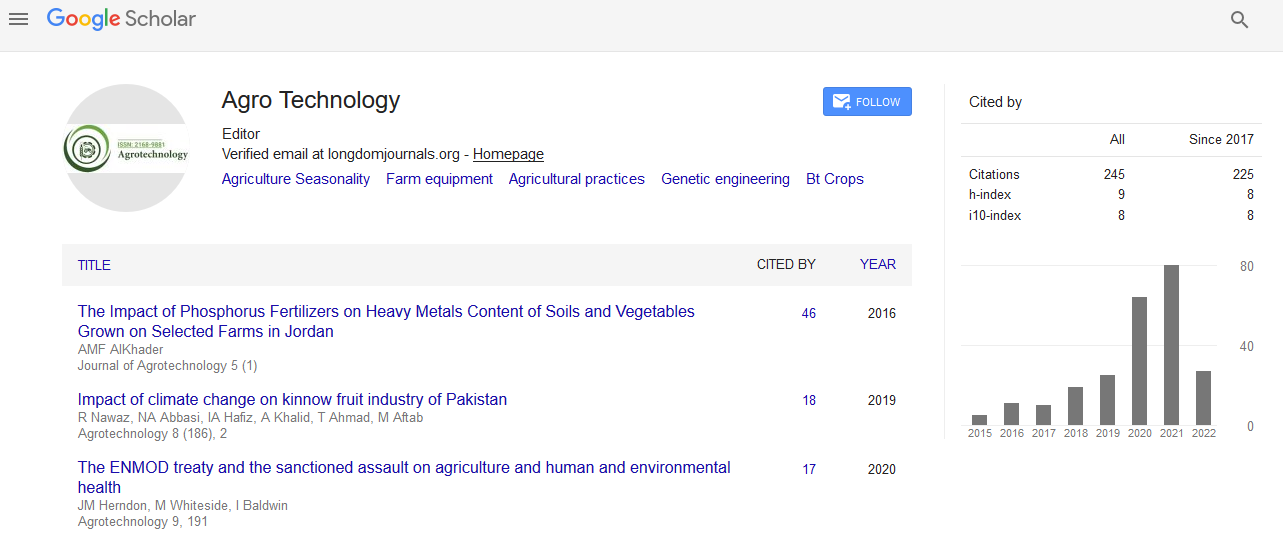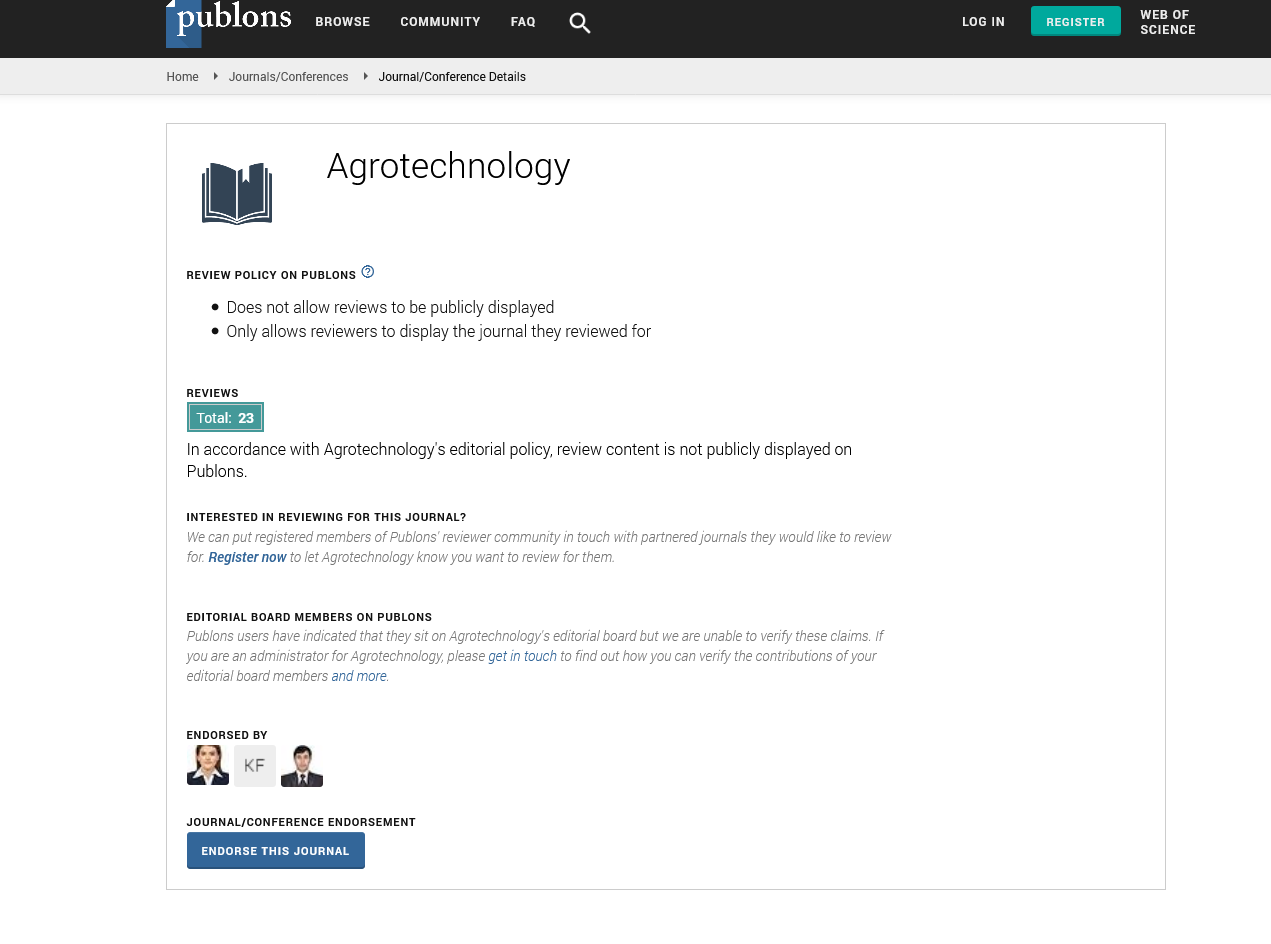Indexed In
- Open J Gate
- Genamics JournalSeek
- Academic Keys
- ResearchBible
- Cosmos IF
- Access to Global Online Research in Agriculture (AGORA)
- Electronic Journals Library
- RefSeek
- Directory of Research Journal Indexing (DRJI)
- Hamdard University
- EBSCO A-Z
- OCLC- WorldCat
- Scholarsteer
- SWB online catalog
- Virtual Library of Biology (vifabio)
- Publons
- Geneva Foundation for Medical Education and Research
- Euro Pub
- Google Scholar
Useful Links
Share This Page
Journal Flyer

Open Access Journals
- Agri and Aquaculture
- Biochemistry
- Bioinformatics & Systems Biology
- Business & Management
- Chemistry
- Clinical Sciences
- Engineering
- Food & Nutrition
- General Science
- Genetics & Molecular Biology
- Immunology & Microbiology
- Medical Sciences
- Neuroscience & Psychology
- Nursing & Health Care
- Pharmaceutical Sciences
Commentary - (2025) Volume 14, Issue 1
Dual Benefits of Biochar for Phosphorus Availability and Arsenic Immobilization
Claire Benton*Received: 19-Feb-2025, Manuscript No. AGT-25-28747; Editor assigned: 21-Feb-2025, Pre QC No. AGT-25-28747 (PQ); Reviewed: 07-Mar-2025, QC No. AGT-25-28747; Revised: 14-Mar-2025, Manuscript No. AGT-25-28747 (R); Published: 21-Mar-2025, DOI: 10.35248/2168-9891.25.14.402
Description
Biochar, a carbon-rich byproduct derived from the pyrolysis of organic materials, has collected significant attention in recent years for its potential to improve soil quality and mitigate environmental contaminants. While biochar is primarily recognized for its role in carbon sequestration, its capacity to simultaneously enhance phosphorus availability and immobilize arsenic in soils presents a unique opportunity for addressing two pressing agricultural and environmental challenges. This dual functionality of biochar enhancing nutrient availability while reducing toxic metal mobility highlights its potential as a sustainable soil amendment that could benefit both agricultural productivity and environmental remediation efforts.
Phosphorus is a significant nutrient for plant growth, but its availability is often limited in soils, particularly in lowphosphorus environments or when soil pH is suboptimal. Traditional phosphorus fertilizers, while effective in supplying crops with the required nutrient, often face issues of inefficiency due to the high fixation of phosphorus in soils, especially in the form of insoluble compounds with calcium, iron, or aluminum. Biochar, with its highly porous structure and large surface area, has shown potential in improving phosphorus availability by adsorbing and retaining phosphorus in a plant-accessible form. Its ability to modify soil properties, such as increasing Cation Exchange Capacity (CEC) and altering soil pH, further contributes to the release of phosphorus from otherwise inaccessible forms.
Research has shown that biochar can interact with phosphorus in a way that reduces its fixation in soils and improves its availability to plants. Specifically, biochar’s surface chemistry, including functional groups like hydroxyl and carboxyl groups, can bind to phosphorus ions, preventing them from forming insoluble complexes with metal ions in the soil. Furthermore, the application of biochar has been reported to increase microbial activity in the rhizosphere, which can also contribute to the mineralization of organic phosphorus and further boost phosphorus availability for crops. These mechanisms underscore the potential of biochar as an effective, low-cost amendment for phosphorus management, particularly in soils with high phosphorus fixation.
On the other hand, the contamination of soils with toxic elements such as Arsenic (As) represents a significant threat to both human health and agricultural productivity. Arsenic is a naturally occurring element that can be mobilized in soils due to factors such as irrigation with contaminated water, fertilizer use and changes in soil pH. Elevated arsenic levels in soils can lead to the uptake of arsenic by plants, which subsequently enter the food chain, posing serious health risks. In this context, biochar’s ability to immobilize arsenic and reduce its bioavailability is an important environmental benefit. The mechanisms by which biochar mitigates arsenic toxicity include adsorption, surface complexation and the formation of stable, less bioavailable arsenic species.
The porous nature of biochar allows it to adsorb arsenic effectively, especially when the biochar is produced from feedstocks rich in carbon and minerals that have a high affinity for arsenic. Several studies have demonstrated that biochar can decrease the mobility of arsenic in soils, particularly in paddy soils, where arsenic is commonly found in soluble forms. By binding to arsenic, biochar reduces its uptake by plants and prevents it from leaching into groundwater, thereby reducing the environmental and health risks associated with arsenic contamination. The immobilization of arsenic also contributes to the overall safety of agricultural produce, making biochar a valuable tool in sustainable farming practices, particularly in regions with arsenic-contaminated soils.
In conclusion, biochar holds significant potential as a multifunctional soil amendment that can improve phosphorus availability and mitigate arsenic contamination in soils. Its ability to enhance nutrient cycling while simultaneously reducing the bioavailability of toxic metals presents an innovative approach to sustainable agriculture. However, the effectiveness of biochar in achieving these dual goals depends on several factors, including feedstock selection, pyrolysis conditions and soil characteristics. As research into biochar continues to evolve, further optimization of its use for both phosphorus management and arsenic immobilization will be critical for unlocking its full potential as a tool for sustainable soil and environmental management.
Citation: Benton C (2025) Dual Benefits of Biochar for Phosphorus Availability and Arsenic Immobilization. Agrotechnology. 14:402.
Copyright: © 2025 Benton C. This is an open access article distributed under the terms of the Creative Commons Attribution License, which permits unrestricted use, distribution, and reproduction in any medium, provided the original author and source are credited.


